西方文学名著导引自然主义文学课件
- 格式:ppt
- 大小:1.85 MB
- 文档页数:25

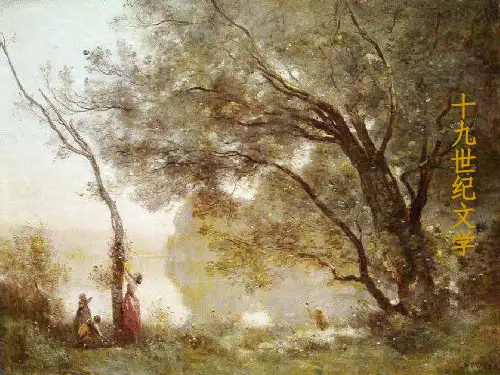
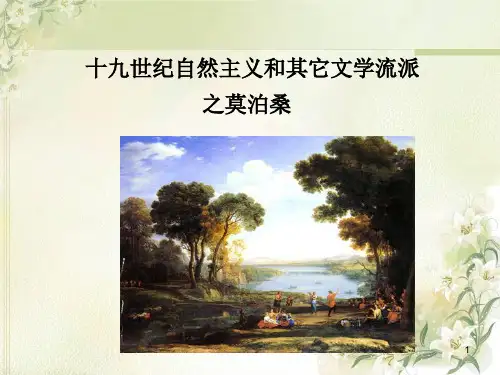
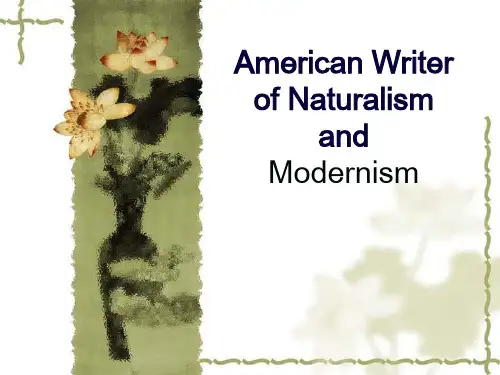

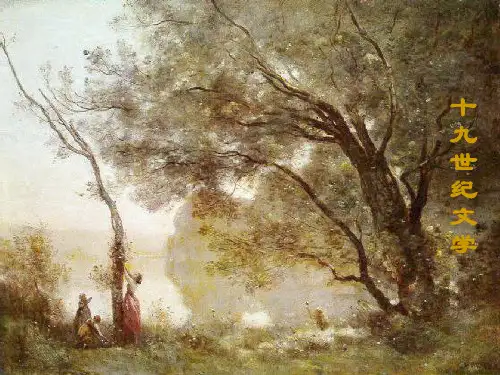


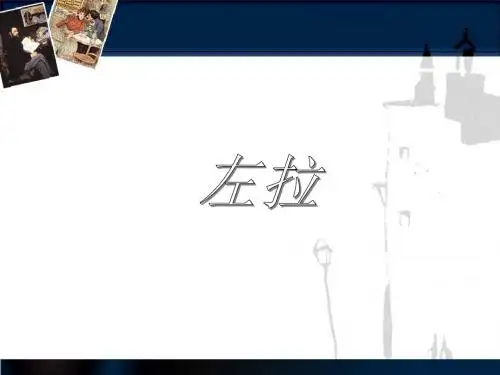

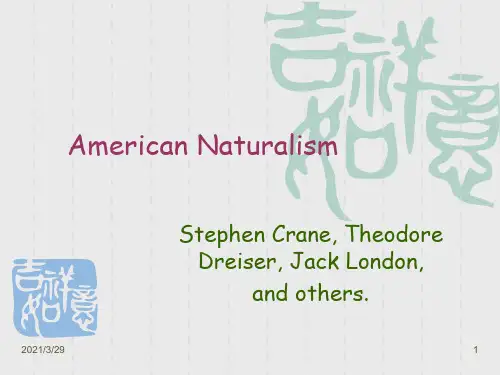
American Naturalism现实主义与自然主义的对比:According the novelist Frank Norris, Realism was the literature of the normal and the representative - "the smaller details of everyday life, things that are likely to happenIn contrast to a Realist, a Naturalist believes that a character is fundamentally an animal, without free will. Thus a character can be explained in terms of the forces, usually heredity and environment, which operate on him/her. between lunch and supper."⏹"Realism is a manner and method of composition by which the authordescribes normal, average life, in an accurate, truthful way."⏹"Naturalism is a manner and method of composition by which theauthor portrays 'life as it is' in accordance with the philosophic theory of determinism."Terms relating to Naturalism⏹Free Will or Determinism -In Naturalism, characters do not have free will; external and internal forces, environment, or heredity control their behavior. This belief is called determinism. All determinists believe in the existence of the will, but the will is often enslaved on account of different reasons.In many ways, naturalism grew out of the foundations laid by earlier realist writers, leading some to call it an “emphasized realism.” It also grew out of the work of French writer Emile Zola (himself influenced by the earlier writings of Balzac and Flaubert), who believed in a world not governed by choice, but determined primarily by heredity and environment.⏹Scientific determinism became Zola’s primary means to understandhuman behavior.He called this new kind of writing Le roman experimental, and here the novelist functioned as more of a scientist. For the writer, direct observation took the place of creative imagination. Life furnished abundant plots and themes for the w riter’s purposes.The significant period of fruition (获得成果)for American naturalist writing is typically seen as stretching from the 1890 to the first two decades of the 20th-century. But dramatic changes had taken place in the United States since the 1870s, and many younger writers felt that peopleneeded a more robust literature to understand the changing times.⏹Writers such as Frank Norris (who profoundly influenced by Zola),Stephan Crane, Jack London, and Theodore Dreiser—all of whom were born in the 1870s—absorbed many of the cultural changes going on during this time. As a result, they created a body of writing where the world seemed indifferent to its human inhabitants.There were dramatic events that were taking place in late 19th-century America. The 1890s were a watershed (分水岭)period, including such changes as:☐The closing of the frontier☐An end to the great days of railroad building, an industry that had helped propel the economy☐The late 19th-century rise of science☐The mid- to late-19th-century influences of Charles Darwin, as well as the later influences of Sigmund Freud☐Technology was growing at a rapid pace☐Powerful monopolies (垄断)owned by a smallnumber of robber barons (巨头) based their philosophy of business not on classical republican ideology but on social Darwinism and laissez faire (自由放任的)practices☐ A large influx (汇集,涌入)of immigrants helped lead to the creation of urban slums (with bad sanitation, poor living conditions, crime gross poverty, etc.)☐Industrialization increased rapidly, leading to child labor and poor labor organizationIn a land that had once believed in the dream of progress, poverty was now a growing nightmare. All of this made realism seem obsolete (退化的), because:◆The idea of the individual negotiating his own fate seemedridiculous◆Realism is based largely on character choice, the world presentedin naturalist text viewed as a matter of coercion (强制,压制)◆The notion of the unified self seemed an illusion◆The idea of tragedy is excluded from naturalism, because if thereis no choice there can be no tragedy◆Because people delude (欺骗,逃避)themselves into believing thatthere are real choices in the world, the theme of illusion-vs-reality takes on special significance in muchnaturalist writing◆The notion of a “surface” world (reality) seemed obso letecompared with determinants (决定因素)from “below” (economics, basic physical needs, sexual drives, natural and social environment, etc.)◆Unlike romanticists, life for naturalists was not beneficent, butdownright hostile◆By the 1890s, realism’s individu al problems seemed nothingcompared to crushing forces seemingly outside human control◆Realism’s concern with everyday life seemed a luxury compared toevents from social and economic forces自然主义的特点:In the world of naturalist fiction:•Characters are motivated by sexual desire, greed, and mob psychology. Many are stereotypes•Details are not important in and of themselves as in realism. In naturalism the symbolism is found in large world issues •Society is divided into the have and have-nots, predator and prey •Life is ugly, brutal, and short•Men and women are not far removed from the animal world•Free will is an illusion•Nature and fate are indifferent to humans•Words like “courage” and “virtue” have no meaning•The world is made up of random events•Everything and everyone is shaped by blind chance and environmental determinism自然主义的困惑:⏹Many naturalist writers, such as Crane, Norris, and Dreiser, begantheir careers as newspaper reporters, observing the world that was seemingly indifferent to human fate. As both journalists and as writers of fiction, they wrote to alert everyone to the bad conditions.⏹This leads to the paradox of naturalism: if the writer writes tochange things, how can they change a determined world?代表作家:Stephen Crane (1871-1900)Whose second book, The Red Badge of Courage(1895), brought him international fame.⏹Crane's first novel, Maggie: A Girl of the Streets, was a milestonein the development of literary naturalism.⏹After leaving school, he went to live in New York, doing freelancewriting and working on his first book Maggie, A Girl of the Streets.⏹He published The Red Badge of Courage in 1895, The Red Badge wasquite different from Maggie in style and approach, and brought Crane international fame and quite a bit of money.⏹Bolstered (鼓舞)by the success of The Red Badge and his book ofpoetry The Black Riders, Crane became subsumed with ideas of war.⏹He was hired to go to Cuba as a journalist to report on the rebellionthere against the Spanish. On the way to the island, Crane was ina shipwreck, from which he was originally reported dead. He rowedto shore in a dinghy, along with three other men, having to swim to shore and drop his money in the sea to prevent from drowning.This experience directly led to his most famous short story "The Open Boat" (1897).His Major WorksNovels⏹Active Service 1899⏹Maggie: A Girl of the Streets 1893⏹The Red Badge of Courage 1895⏹The Little Regiment 1896⏹The O’Ruddy 1903⏹The third Violet 1897Short Stories⏹The Open Boat 1898⏹The Monster 1899⏹Wilomville Stories 1900⏹Men, Women and Boats 1921Poems⏹The Black Riders 1895⏹War is Kind1899Historical book⏹Great Battles of the War 1901Major Themes⏹In his themes and styles, Crane is an avant-garde (先锋派)writer.⏹Crane writes about extreme experiences that are confronted byordinary people.⏹His characters are not larger-than-life, but they touch themysterious edges of their capacities for perception, action, and understanding.⏹The New York City sketch, "A Detail," was reprinted in 1898 with"The Open Boat," and the two works express parallel naturalistic themes.⏹In both, individuals are shown to struggle for communication whilebeing buffeted by tumultuous forces.Significant Style⏹Crane's works reflect many of the major artistic concerns at theend of the nineteenth century, especially naturalism, impressionism, and symbolism.⏹His works insist that people live in a universe of vast andindifferent natural forces, not in a world of divine providence ora certain moral order. "A Man Said to the Universe" is useful inidentifying this aspect of Crane.⏹Crane's vivid and explosive prose styles distinguish his works fromthose by many other writers who are labeled naturalists.⏹Many readers (including Hamlin Garland and Joseph Conrad, who werepersonal friends of Crane) have used the term impressionist to describe Crane's vivid renderings of moments of visual beauty and uncertainty.The red Badge of Courage 《红色勇敢标志》⏹Commonly considered Stephen Crane's greatest accomplishment, TheRed Badge of Courage (1895) ranks among the foremost literary achievements of the modern era.⏹When Crane signed a contract with D. Appleton and Co. to publishRed Badge, he was not well-known enough to command an advance, and agreed to a flat 10 per cent royalty on the retail price of all copies sold.⏹Published in the autumn of 1895, Red Badge went through two editionsbefore the end of the year.⏹By March of 1896 the novel was in eighth place on the internationalbooksellers' list and had gone through fourteen printings;remarkably enough, Red Badge has never been out of print.⏹With the publication of Red Badge, Crane achieved almost overnightcelebrity.⏹During an unnamed battle, 18-year-old private Henry Flemingsurvives what he considers to be a lost cause by escaping into the nearby forest, deserting his battalion.⏹He then finds a group of injured men in which One of the group, the"Tattered Soldier", asks Henry, who is often referred to as "The Youth", where he is wounded.Henry, embarrassed that he does not have any wounds, wanders through the forest. He ultimately decides that running was the best thing, and that he is a small part of the army responsible for saving himself.⏹When he learns that his battalion had won the battle and that itwas not a suicide mission after all, Henry feels incredibly guilty.As a result, he returns to his battalion and is injured when a cannon operater hits Henry in the head because he wouldn't let go of his arm.⏹When he returns to camp, the other soldiers believe that he washarmed by a bullet grazing him in battle. The next morning he goes into battle for the third time. While looking for a stream to attain water from, he discovers from the commanding officer that his regiment has a lackluster reputation.⏹The officer speaks casually about sacrificing Henry's regimentbecause they are nothing more than "mule drivers" and "mud diggers".With no regiments to spare, the general orders his men forward. In the final battle, Henry becomes one of the best fighters in his battalion as well as the flag bearer, finally proving his courage as a man.Character ListHenry Fleming⏹The novel’s protagonist; a young soldier fighting for the Unionarmy during the American Civil War. Initially, Henry stands untested in battle and questions his own courage.⏹As the novel progresses, he encounters hard truths about theexperience of war, confronting the universe’s indifference to his existence and the insignificance of his own life.⏹Often vain and holding extremely romantic notions about himself,Henry grapples with these lessons as he first runs from battle, then comes to thrive as a soldier in combat.Jim Conklin⏹Henry’s friend; a tall soldier hurt during the regiment’s firstbattle. Jim soon dies from his wounds, and represents, in the early part of the novel, an important moral contrast to Henry.Wilson⏹ A loud private; Henry’s friend in the regiment. Wilson and Henrygrow close as they share the harsh experiences of war and gain a reputation as the regiment’s best fighters.The tattered soldier⏹ A twice-shot soldier whom Henry encounters in the column of woundedmen. With his endless speculation about Henry’s supposed wound, the tattered(衣衫褴褛的)soldier functions as a nagging, painful conscience to Henry.The lieutenant⏹Henry’s commander in battle, a youthful officer who swearsprofusely during the fighting. The lieutenant develop sympathy for each other, often feeling that they must work together to motivate the rest of the men.Henry’s mother⏹Encountered only in a brief flashback, Henry’s mother opposed hisenlisting in the army.⏹Though her advice is only briefly summarized in Henry’s flashback,it contains several difficult themes with which Henry must grapple, including the insignificance of his life in the grand scheme of the world.Major ThemesCourage⏹Given the novel’s title, it is no surprise that courage—definingit, desiring it, and, ultimately, achieving it—is the most salient element of the narrative.Manhood⏹Throughout the novel, Henry struggles to preserve his manhood, hisunderstanding of which parallels his understanding of courage.Self-Preservation⏹An anxious desire for self-preservation influences Henrythroughout the novel.The Universe’s Disregard for Human Life⏹Henry’s realization that the natural world spins on regardless ofthe manner in which men live and die is perhaps the most difficult lesson that Henry learns as a soldier.Youth and Maturity⏹Although the novel spans no more than a few weeks, the readerwitnesses a profound change in the characters of both Henry and WilsonTheodore Dreiser (1871-1945)⏹American author, outstanding representative of naturalism, whosenovels depict real-life subjects in a harsh light⏹After briefly attending Indiana University, he found work as areporter on the Chicago Globe. Later he worked for the St. Louis Globe-Democrat, the St. Louis Republic and Pittsburgh Dispatch, before moving to New York where he attempted to establish himself as a novelist.⏹He was a voracious(如饥似渴的) reader, and the impact of suchwriters as Hawthorne, Poe, Balzac, Herbert Spencer, and Freud influenced his thought and his reaction against organized religion.⏹Dreiser worked for the New York World before Frank Norris, who wasworking for Frank Doubleday, helped Dreiser's first novel, Sister Carrie(1900), to be published. However, the owners disapproved of the novel's subject matter (the moral corruption of the heroine, Carrie Meeber) and it was not promoted and therefore sold badly.⏹Dreiser was left-oriented in his views.⏹Dreiser continued to work as a journalist and as well as writingfor mainstream newspapers such as the Saturday Evening Post, also had work published in socialist magazines such as The Call. However, unlike many of his literary friends such as Sinclair Lewis, and Jack London, he never joined the Socialist Party.1. Works⏹Sister Carrie 1900⏹ Jennie Gerhardt 1911⏹ An American Tragedy 1925⏹ The Financier 1912⏹ The Titan 1914 Trilogy of Desire⏹ The Stoic (posthumously) Trilogy of Desire⏹ The Genius 1915 Trilogy of Desire⏹ Dreiser Looks at Russia 1928 autobiographically⏹The Financier (1912) and The Titan (1914) about Frank Cowperwood,a power-hungry business tycoon.⏹An American Tragedy (1925) was based on the Chester Gillette andGrace Brown murder case that had taken place in 1906.2. About Sister CarrieSister Carrie, published in 1900, stands at the gateway of the new century. Theodore Dreiser based his first novel on the life of his sister Emma. In 1883 she ran away to Toronto, Canada with a married man who had stolen money from his employer. The story as told by Dreiser, about Carrie Meeber who becomes the mistress of a traveling salesman, is unapologetically told and created a scandal with its moral transgressions(违反道德准则).⏹The book was initially rejected by many publishers on the groundsthat is was “immoral”. Indeed, Harper Brothers, the firstpublisher to see the book, rejected it by saying it was not, “sufficiently delicate to depict without offense to the reader the continued illicit (违禁的)relations of the heroine".⏹Finally Doubleday and Company published the book in order to fulfilltheir contract, but Frank Doubleday refused to promote the book.As a result, it sold less than seven hundred copies and Dreiser received a reputation as a naturalist-barbarian.⏹Sister Carrie sold poorly but was redeemed by writers like FrankNorris and William Dean Howells who saw the novel as a breakthrough in American realism.⏹However, the publication battles over Sister Carrie caused Dreiserto become depressed, so much so that his brother sent him to a sanitarium for a short while.Sister Carrie, published in 1900, is one of the best-known story of American Dream, tracing the material rise of Carrie Meeber and the tragic decline of G. W. Hurstwood.⏹Carrie Meeber, penniless and full of the illusion of ignorance andyouth, leaves her rural home to seek work in Chicago. On the train, she becomes acquainted with Charles Drouet, a salesman. In Chicago, she lives with her sister, and work for a time in a shoe factory.⏹Meager income and terrible working condition oppress herimaginative spirit. After a period of unemployment and loneliness, she accepts Drouet and becomes his mistress.⏹During his absence, she falls in love with Drouet’s friendHurstwood, a middle aged, married, comparatively intelligent culture saloon manager. They finally elope. They live together for three years more.⏹Carrie becomes mature in intellect and emotion, while Hurstwoodsteadily declines. At last, she thinks him too great a burden and leaves him. Hurstwood sinks lower and lower. After becoming a beggar, he commits suicide, while Carrie becomes a star of musical comedy.In spite of her success, she is lonely and dissatisfied.⏹The theme in Sister Carrie, a novel written by Theodore Dreiser,is materialism. The theme is primarily personified through Carrie with her desire for a fine home, clothes and everything else money can buy.⏹Materialism, including the desire for money, is an important themein Sister Carrie. The materialism is shown mostly through Carrie's character but also through Hurstwood, a man with a respectable life and money, who still wants more and for that reason commits a crime.⏹The city in itself is also a place of materialism, it is a placethat offers all kinds of amusements, pleasures and things to buy, but to participate in what the city has to offer one has to havemoney.3. EvaluationHe faced every form of attack that a serious artist could encounter misunderstanding, misrepresentation, artistic isolation and commercial seduction. But he survived to lead the rebellion of the 1900s.Dreiser has been a controversial figure in American literary history.His works are powerful in their portrayal of the changing American life, but his style is considered crude.It is in Dreiser’s works that American naturalism is said to have come of age.Dreiser’s novels are formless at times and awkwardly written, and his characterization is found deficient and his prose pedestrian and dull, yet his very energy proves to be more than a compensation.Dreiser’s stories are always solid and intensely interesting with their simple but highly moving characters. Dreiser is good at employing the journalistic method of reiteration to burn a central impression into the reader’s mind.For a commemorative service in 1947, H. L. Mencken wrote a eulogy in which he stuck by the argument that he had been making for over thirty-five years: despite Dreiser's flaws as a stylist, "the fact remains that he is a great artist, and that no other American of his generation left so wide and handsome a mark upon the national letters.American writing, before and after his time, differed almost as much as biology before and after Darwin. He was a man of large originality, of profound feeling, and of unshakable courage. All of us who write are better off because he lived, worked, and hoped."Here lies the power and permanence that have made Dreiser one of America’s foremost novelists.。